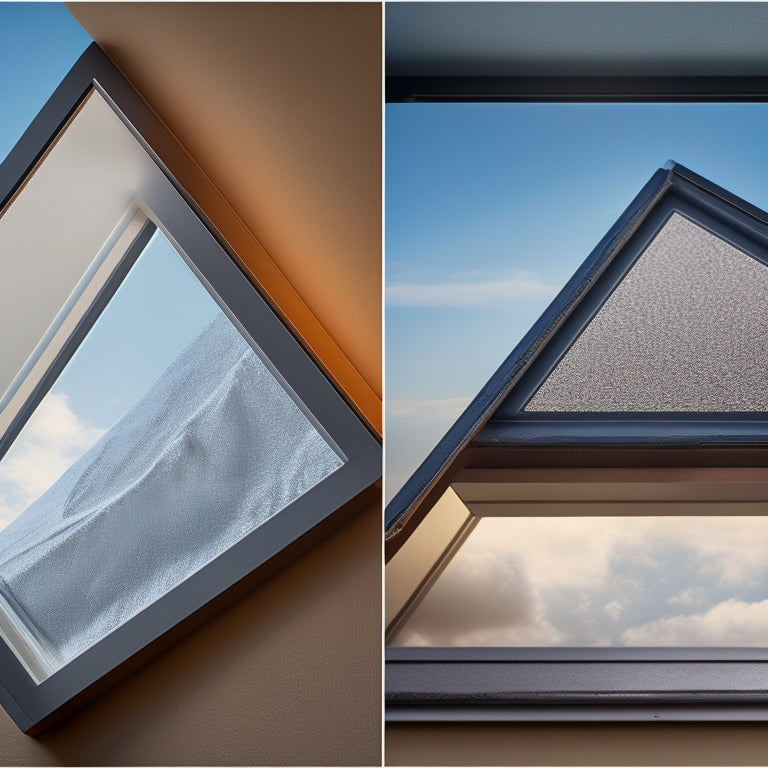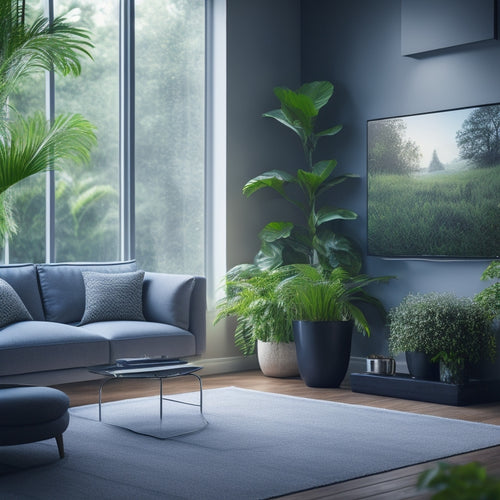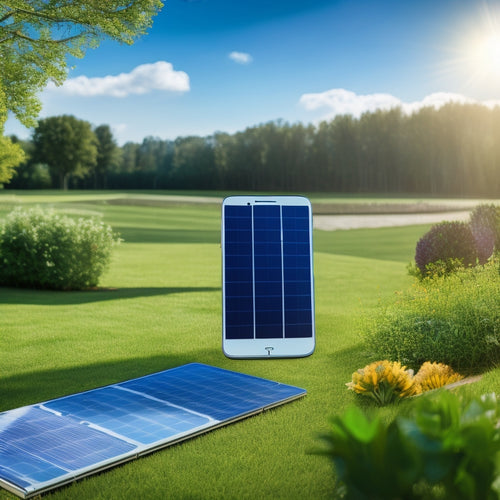
What Weatherstripping Materials Best Insulate Skylight Windows?
Share
When it comes to insulating skylight windows, you need weatherstripping materials that can effectively seal gaps and prevent energy loss. The best options include eco-friendly materials like recycled foam, natural fiber tape, and soy-based sealants that reduce carbon footprint while maintaining indoor climate comfort. These sustainable materials not only reduce energy bills but also contribute to a cleaner environment. By choosing the right weatherstripping material, you can minimize air leaks and heat transfer, ensuring a more energy-efficient and comfortable living space. Now that you've got a solid starting point, investigate the specifics of each material to find the perfect fit for your skylight windows.
Key Takeaways
- Foam tape offers high compression rate and ease of installation, making it a popular DIY choice for skylight window insulation.
- EPDM rubber withstands extreme temperatures, is UV stable, and provides excellent energy efficiency, making it a top pick for skylight insulation.
- Silicone weatherstripping provides exceptional flexibility, resilience against temperature fluctuations, and is ideal for high-vibration areas.
- Vinyl weatherstripping is the most durable option, ideal for high wind pressure areas, and requires low maintenance for optimal performance.
- Natural Fiber Tape, made from sustainable sources, is biodegradable, non-toxic, and compostable, offering an eco-friendly insulation solution for skylight windows.
Understanding Skylight Window Insulation
Your skylight window's thermal performance greatly impacts your home's energy efficiency and comfort level. Proper skylight insulation techniques are essential to prevent energy loss and maintain a consistent indoor climate.
When heat escapes through your skylight, it not only increases your energy bills but also puts a strain on the environment. Incorporating fast charging infrastructure and leveraging renewable energy sources can considerably reduce carbon emissions.
To combat this, you can employ various skylight insulation techniques, such as applying thermal insulation materials, installing radiant barrier systems, or using reflective insulation.
Benefits of Sustainable Weatherstripping
You'll find that sustainable weatherstripping for your skylight windows offers two significant advantages.
By choosing eco-friendly material options, you're reducing your carbon footprint and minimizing the environmental impact of your home.
Moreover, sustainable weatherstripping can provide an energy efficiency increase, helping you save on heating and cooling costs.
As seen in renewable energy solutions, incorporating eco-friendly practices can lead to a cleaner environment and enhance brand reputation.
In addition, promoting climate action through sustainable weatherstripping can dramatically reduce greenhouse gas emissions.
Eco-Friendly Material Options
Between the skylight window's frame and sash, a gap exists that allows air to escape and infiltrate. You can seal this gap with eco-friendly weatherstripping materials that not only reduce air leaks but also minimize environmental impact.
| Material | Eco-Friendly Feature | Benefits |
|---|---|---|
| Recycled Foam | Made from recycled materials | Reduces waste, conserves natural resources |
| Natural Fiber Tape | Derived from sustainable sources | Biodegradable, non-toxic, and compostable |
| Soy-Based Sealant | Renewable resources, biodegradable | Low carbon footprint, non-toxic, and eco-certified |
When choosing eco-friendly weatherstripping, look for products made from recycled materials, natural fibers, or biodegradable options. Confirm the manufacturer adheres to sustainable sourcing practices and possesses eco certifications. By making eco-conscious choices, you'll reduce your carbon footprint and contribute to a greener building environment.
Energy Efficiency Boost
By sealing the gap between the skylight window's frame and sash with eco-friendly weatherstripping, you can reap significant energy efficiency benefits.
This is especially important for skylight maintenance, as air leaks can lead to energy losses and increased energy bills.
Additionally, adopting renewable energy sources, such as solar power, can further reduce your carbon footprint and energy costs.
Shifting to renewable energy can lead to 70% annual fuel cost savings, which can be reinvested for business growth and development.
- Reduce heat transfer and minimize energy losses in winter and summer
- Lower your energy bills and enjoy significant energy savings
- Create a more comfortable living space with consistent indoor temperatures
- Contribute to a sustainable future by reducing your carbon footprint
Types of Weatherstripping Materials
Three primary types of weatherstripping materials are commonly used for skylight windows: foam tape, felt, and vinyl.
You'll find that each type has its unique characteristics, advantages, and disadvantages. Foam tape is a popular choice due to its high compression rate and ease of installation.
With the increasing adoption of electric vehicles, it's crucial to reflect on sustainable charging practices, such as utilizing green energy charging infrastructure that lowers carbon footprint.
Felt, on the other hand, is a cost-effective option that provides decent insulation. Vinyl, being the most durable, is ideal for areas with high wind pressure.
When selecting a weatherstripping type, take into account factors such as climate, budget, and desired level of insulation.
Foam Tape Weatherstripping Options
As you consider foam tape weatherstripping options for your skylight windows, you'll find that this popular choice offers a range of benefits and features that make it an attractive solution.
Foam tape weatherstripping is known for its ease of installation, making it a great DIY project. It's also relatively inexpensive compared to other weatherstripping materials.
When selecting a solar panel for your vehicle, consider high-efficiency photovoltaic cells to maximize energy generation. Additionally, look for durable materials with weather resistance to guarantee longevity.
-
Foam tape properties include high compressibility, making it ideal for sealing gaps of varying sizes.
-
It's available in various thicknesses and densities to suit different skylight window types.
-
Weatherstripping maintenance is minimal, as foam tape is resistant to mold, mildew, and UV degradation.
- It's also an environmentally friendly option, as many foam tapes are made from recycled materials.
Vinyl Weatherstripping for Skylights
Vinyl weatherstripping for skylights offers a durable and long-lasting solution for sealing gaps and preventing air leaks.
You'll appreciate its vinyl durability, which guarantees it can withstand harsh weather conditions and maintain its seal over time.
Additionally, vinyl flexibility allows it to adapt to the unique shape and size of your skylight, providing a snug fit that prevents air from escaping.
When you choose vinyl weatherstripping, you can expect a reduction in energy costs and a more comfortable living space.
Its ease of installation and low maintenance requirements make it an ideal choice for homeowners seeking freedom from energy waste and unwanted temperature fluctuations.
Felt Weatherstripping Advantages
You'll find that felt weatherstripping offers several advantages when it comes to sealing your skylight windows.
For one, it's incredibly easy to install, requiring minimal tools and skill.
Additionally, felt weatherstripping features a long-lasting adhesive and comes in durable material options that can withstand harsh weather conditions.
Easy Installation
Most skylight window installations require a snug fit to prevent air leaks and moisture intrusion, and felt weatherstripping excels in this regard.
You can easily install felt weatherstripping using simple installation techniques that guarantee a secure fit. This minimizes the risk of air leaks and moisture intrusion, providing you with the freedom to enjoy your skylight window without worrying about energy efficiency or water damage.
- Felt weatherstripping can be cut to fit your skylight window's unique dimensions
- It's easy to apply, even for DIY enthusiasts with limited experience
- You can use it to fill gaps between moving parts, guaranteeing a tight seal
- Regular weatherstrip maintenance is a breeze, as felt weatherstripping can be easily replaced or cleaned
Long-Lasting Adhesive
Three key benefits of felt weatherstripping's long-lasting adhesive are its exceptional durability, resistance to harsh weather conditions, and ability to maintain a secure bond over time.
You'll appreciate the adhesive's performance in extreme temperatures, where it continues to provide a reliable seal. This means you can enjoy the freedom to focus on other aspects of your home, knowing your skylight windows are well-insulated.
The long-term bonding capability guarantees that the adhesive remains effective even after repeated exposure to weather fluctuations.
With felt weatherstripping, you can trust that the adhesive will hold strong, providing a consistent and reliable seal that keeps the elements out and the comfort in.
Durable Material Options
Since felt weatherstripping is a popular choice for skylight windows, its durable material options play a significant role in its overall performance.
You'll want to take into account the following advantages of felt weatherstripping when evaluating its weatherstripping performance:
-
Resistance to compression: Felt weatherstripping can withstand compression without losing its shape, ensuring a consistent seal.
-
High-density materials: Felt weatherstripping is made from dense materials that resist air leaks and provide a tight seal.
-
Durability in extreme temperatures: Felt weatherstripping can withstand extreme temperatures without deteriorating, making it an excellent choice for skylight windows.
- Low maintenance: Felt weatherstripping requires minimal maintenance, as it resists dirt and debris accumulation, ensuring peak performance.
Metal Weatherstripping Durability
You'll find that metal weatherstripping is a popular choice for skylight windows due to its exceptional durability. This material's sturdy performance guarantees a long-lasting seal, even in harsh weather conditions.
Metal weatherstripping's durability stems from its resistance to corrosion, warping, and cracking. With proper metal weatherstripping maintenance, such as regular cleaning and inspections, you can expect a lifespan of up to 20 years or more.
Its impressive performance is also attributed to its ability to withstand extreme temperatures, making it an ideal choice for skylight windows that are exposed to direct sunlight.
EPDM Rubber Weatherstripping
You'll find that EPDM rubber weatherstripping offers a range of benefits, including its ability to seal gaps effectively and provide long-lasting performance.
Its flexibility allows it to conform to unique skylight window shapes, ensuring a tight seal that keeps air and water out.
With EPDM rubber weatherstripping, you can expect durability and longevity, making it a reliable choice for your skylight window weatherstripping needs.
EPDM Rubber Benefits
EPDM rubber weatherstripping offers unparalleled durability and performance, making it an ideal choice for skylight windows.
You'll appreciate its numerous benefits, which include:
-
Resistance to extreme temperatures: EPDM rubber withstands temperatures ranging from -50°C to 150°C, ensuring a reliable seal in any climate.
-
Chemical resistance: EPDM rubber is inert to most chemicals, guaranteeing its integrity in harsh environments.
-
UV stability: EPDM rubber remains flexible and intact when exposed to direct sunlight, preserving its sealing properties.
- Low compression set: EPDM rubber maintains its shape and seal even under prolonged pressure, ensuring a consistent performance.
These EPDM advantages make it an excellent material for various EPDM applications, including skylight windows, where a reliable seal is essential for energy efficiency and weather protection.
Seal Gaps Effectively
When installing skylight windows, even the tiniest gaps can lead to significant energy losses and water damage. That's why it's vital to seal gaps effectively. EPDM rubber weatherstripping is an excellent choice for this purpose. It's important to select the right type of weatherstripping to guarantee a tight seal. Consider the following factors when choosing EPDM rubber weatherstripping:
| Gap Size | Weatherstripping Type | Effectiveness |
|---|---|---|
| Small (1-2 mm) | Closed-cell EPDM | High |
| Medium (2-5 mm) | Open-cell EPDM | Medium |
| Large (5-10 mm) | Foam-backed EPDM | Low |
Durability and Longevity
By the time you've completed the installation of your skylight windows, ensuring the durability and longevity of the weatherstripping is essential to maintaining a tight seal.
EPDM rubber weatherstripping is a top choice for skylight windows due to its exceptional durability and resistance to harsh weather conditions.
Key factors to evaluate for durability and longevity include:
-
Material selection: EPDM rubber is a highly resistant material that can withstand extreme temperatures, UV rays, and ozone.
-
Weather resistance: EPDM rubber is impermeable to water, air, and moisture, ensuring a tight seal even in harsh weather conditions.
-
Installation quality: Proper installation is critical to ensuring the weatherstripping lasts for years to come.
- Maintenance routine: Regularly inspecting and cleaning the weatherstripping can extend its lifespan.
Silicone Weatherstripping Flexibility
Frequently, silicone weatherstripping is preferred for skylight windows due to its exceptional flexibility, which allows it to adapt to varying environmental conditions and window frame movements.
As you consider weatherstripping options, you'll appreciate silicone's ability to withstand temperature fluctuations without compromising its seal. This temperature adaptability guarantees a consistent performance, even in extreme weather conditions.
Silicone's resilience also enables it to absorb shocks and vibrations, maintaining its shape and seal integrity.
When installed correctly, silicone weatherstripping provides a reliable barrier against air leaks and moisture intrusion, assuring your skylight windows remain energy-efficient and free from water damage.
Installing Weatherstripping for Skylights
You've chosen silicone weatherstripping for your skylight windows due to its exceptional flexibility and temperature adaptability.
Now, it's time to install it correctly to guarantee the best skylight maintenance and weatherproofing techniques.
To secure a successful installation:
-
Clean the skylight frame and surrounding area to remove dirt, dust, and old adhesive residue.
-
Measure and cut the weatherstripping to fit the skylight's dimensions, leaving a 10% overlap for secure adhesion.
-
Apply the weatherstripping, starting from the center and working your way outward, guaranteeing a smooth, even application.
- Inspect the weatherstripping for any gaps or wrinkles, and reapply as needed to confirm a watertight seal.
Frequently Asked Questions
Can Weatherstripping Be Used on Old or Damaged Skylight Windows?
Surprisingly, you can salvage that old, damaged skylight window with some TLC! You can definitely use weatherstripping on it, and even investigate skylight repair options to enhance insulation, giving you more freedom to enjoy natural light without the heat loss.
How Do I Clean Weatherstripping on Skylight Windows Effectively?
You'll maintain your skylight's weatherstripping effectively by employing gentle cleaning techniques, like soft-bristled brush sweeps and mild soap solutions, ensuring thorough rinses, and performing regular weatherstripping maintenance to guarantee maximum energy efficiency and unobstructed views.
Are There Any DIY Weatherstripping Kits Available for Skylights?
You'll be surprised to know that 70% of skylights lack proper weatherstripping, leading to heat loss. For effective skylight maintenance, you can find DIY weatherstripping kits that offer advanced insulation techniques, providing you the freedom to seal your skylight efficiently and cost-effectively.
Do I Need to Replace Weatherstripping on Skylights Every Year?
You don't need to replace weatherstripping on skylights every year, but regular skylight maintenance is essential; the weatherstripping lifespan typically ranges from 5 to 10 years, depending on environmental factors and quality of installation.
Can I Use Weatherstripping on Skylights With Unique or Custom Shapes?
You've got a skylight shaped like a work of art - a curved creation! Don't worry, you can still find weatherstripping to fit its custom shape, but be prepared for some installation challenges that'll test your patience and skills.
Related Posts
-

7 Best Home Hydrogen Fuel Cells for Clean Power
You're considering adopting hydrogen fuel cells for clean power at home, but you want to know the best options. Reput...
-

7 Best Solar Panel Upkeep Apps for Homeowners
You can optimize your solar panel's energy output and efficiency by up to 20% with regular maintenance, which is wher...
-

7 Smart Air Purification Hacks for Energy-Savvy Homes
You can notably improve your indoor air quality while minimizing energy consumption by implementing strategic air pur...


